Vault basics
Following our previous Vault 101, here is another Vault article, this time about some vault basics (again)
The Agenda:
- Where we are
- Adding users to Vault
- Storing secrets in Vault
- Understanding the path
- Managing access to Vault
Let’s get started!
1 Where we are
At the end of the previous article, we had a working stand alone Vault server. At this point, we can start the server, and because we configured auto unseal with Azure keyvault, we get an unseal server after boot
yumemaru@df-2404lts:~$ vault status
Key Value
--- -----
Seal Type azurekeyvault
Recovery Seal Type shamir
Initialized true
Sealed false
Total Recovery Shares 3
Threshold 2
Version 1.18.3
Build Date 2024-12-16T14:00:53Z
Storage Type raft
Cluster Name vault-cluster-6c316402
Cluster ID 9d7a0fd1-34b1-afb9-a239-66ccc4368d71
HA Enabled true
HA Cluster https://192.168.56.11:8201
HA Mode active
Active Since 2025-01-03T17:13:15.795033947Z
Raft Committed Index 55
Raft Applied Index 55
By default, the available authentication method is token, so we need to have the root token available to logon.
With the token, we can log as root through the UI:
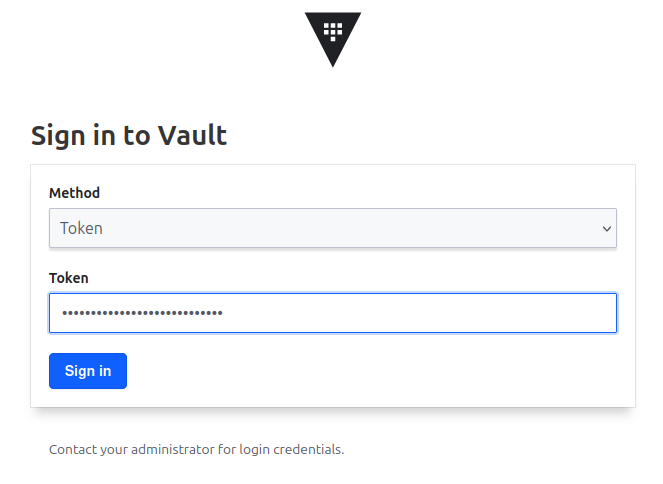

Or with the vault cli:
yumemaru@df-2404lts:~$ vault login
Token (will be hidden):
Success! You are now authenticated. The token information displayed below
is already stored in the token helper. You do NOT need to run "vault login"
again. Future Vault requests will automatically use this token.
Key Value
--- -----
token hvs.xxxxxxxxxxxxxxxxxxxxxxxx
token_accessor xxxxxxxxxxxxxxxxxxxxxxx
token_duration ∞
token_renewable false
token_policies ["root"]
identity_policies []
policies ["root"]
2. Adding users to Vault
At this point, we only have the token authentication method and nothing else.
yumemaru@df-2404lts:~$ vault auth list
Path Type Accessor Description Version
---- ---- -------- ----------- -------
token/ token auth_token_d7e2d457 token based credentials n/a
If we want to start having users, we need to plan for an authentication method. There are a lot of interesting options but for now, we’ll use the userpass authentication, to illustrate a simple authentication, and we’ll focus on others functionnalities of Vault.
That can be done through the vault cli.
yumemaru@df-2404lts:~$ vault auth enable userpass
Success! Enabled userpass auth method at: userpass/
Now we can see the userpass in the authentication method.
yumemaru@df-2404lts:~$ vault auth list
Path Type Accessor Description Version
---- ---- -------- ----------- -------
token/ token auth_token_d7e2d457 token based credentials n/a
userpass/ userpass auth_userpass_671751c5 n/a n/a
Notice the Path output. Everything uses path in Vault so that’s important. At this point, we don’t have any user, so let’s do this. We can either refer to the vault cli documentation or the api documentation
yumemaru@df-2404lts:~$ export userpassword="xxxxxxxxxxxxxxxxxxxx"
yumemaru@df-2404lts:~$ vault write auth/userpass/users/david
Must supply data or use -force
yumemaru@df-2404lts:~$ vault write auth/userpass/users/david password=$userpassword
Success! Data written to: auth/userpass/users/david
yumemaru@df-2404lts:~$ vault write auth/userpass/users/sheldon password=$userpassword
Success! Data written to: auth/userpass/users/sheldon
The user creation requires to specify a password in this case, as can be expected.
Using the rest API, it looks like this:
yumemaru@df-2404lts:~$ curl --request POST --data '{"password": "xxxxxxxxxxxxxxxxxxxx"}' --header "X-Vault-Token:hvs.xxxxxxxxxxxxxxxxxxxxxxxx" http://192.168.56.11:8200/v1/auth/userpass/users/penny
We can check the new users in the userpass authentication, with the cli, the api or through the UI
yumemaru@df-2404lts:~$ curl --request LIST --header "X-Vault-Token:hvs.xxxxxxxxxxxxxxxxxxxxxxxx" http://192.168.56.11:8200/v1/auth/userpass/users/ | jq .
% Total % Received % Xferd Average Speed Time Time Time Current
Dload Upload Total Spent Left Speed
100 218 100 218 0 0 88726 0 --:--:-- --:--:-- --:--:-- 106k
{
"request_id": "c1052b0d-fb82-f09b-8b81-12775704f50b",
"lease_id": "",
"renewable": false,
"lease_duration": 0,
"data": {
"keys": [
"david",
"penny",
"sheldon"
]
},
"wrap_info": null,
"warnings": null,
"auth": null,
"mount_type": "userpass"
}
yumemaru@df-2404lts:~$ vault list auth/userpass/users
Keys
----
david
penny
sheldon

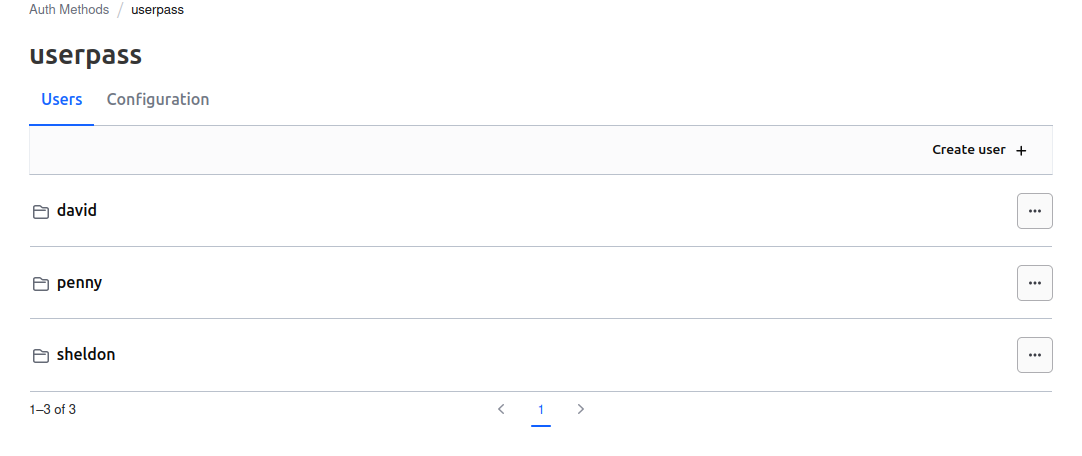
We are now able to logon as one of those user. Let’s try it from the UI
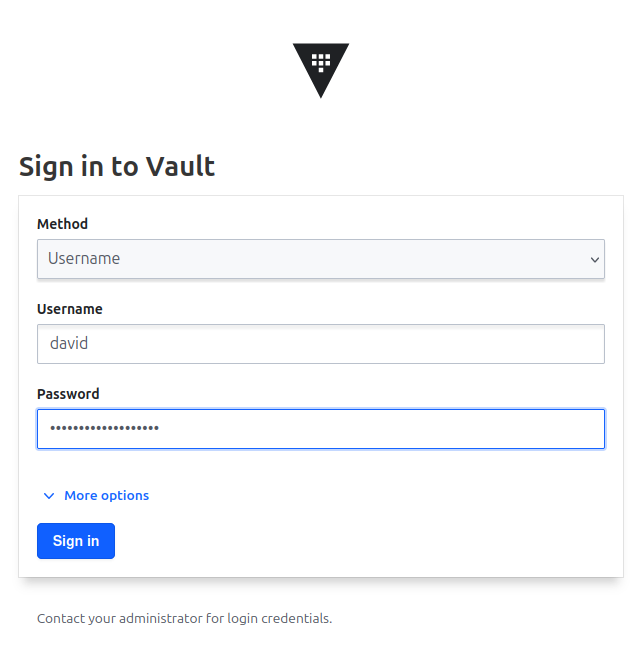
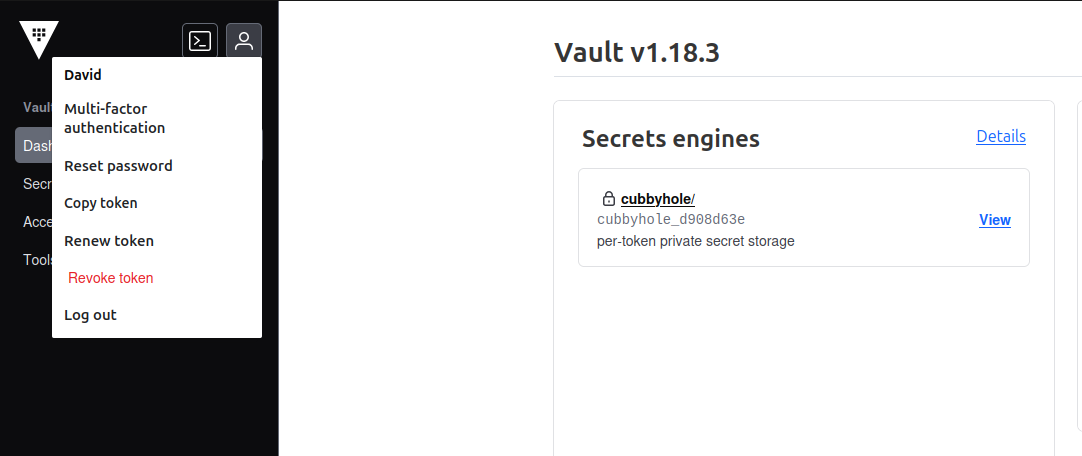

And we don’t see much, because, well, we did not specify any access.
Using the cli, by refering to the doc, we get the same result, with an explicit deny message, which confirms what we know about Vault: by default, everything is denied.
df@df-2404lts:~$ vault login -method=userpass username=david
Password (will be hidden):
Success! You are now authenticated. The token information displayed below
is already stored in the token helper. You do NOT need to run "vault login"
again. Future Vault requests will automatically use this token.
Key Value
--- -----
token hvs.xxxxxxxxxxxxxxxxxxxxxxxxxxxxxxxxxxxxxxxxxxxxxxxxxxxxxxxxxxxxxxxxxx
token_accessor yyyyyyyyyyyyyyyyyyyyyyyy
token_duration 768h
token_renewable true
token_policies ["default"]
identity_policies []
policies ["default"]
token_meta_username david
df@df-2404lts:~$ vault list auth/userpass/users
Error listing auth/userpass/users: Error making API request.
URL: GET http://192.168.56.11:8200/v1/auth/userpass/users?list=true
Code: 403. Errors:
* 1 error occurred:
* permission denied
The interesting information here is the policies, which specify ["default"]. We’ll have a look at the Vault policies in the coming sections. For now, let’s start playing with secrets.
3. Storing secrets in Vault
In this section, we, at last, start storing secrets in Vault. Toget start, let’s enable a secret engine first.
Again, there are many different secret engines in Vault, but we’ll start with the simple kv engine.
There are 2 versions for the kv engine. v1 and v2. The version 2 allows additional features such as secret versioning, so we’ll use this one.
To enable the kv v2 engine, we can use the vault cli.
df@df-2404lts:~$ vault secrets enable -version 2 -path /tbbtkv kv
Success! Enabled the kv secrets engine at: /tbbtkv/
And list the secrets engine:
df@df-2404lts:~$ vault secrets list
Path Type Accessor Description
---- ---- -------- -----------
cubbyhole/ cubbyhole cubbyhole_d908d63e per-token private secret storage
identity/ identity identity_08b8e281 identity store
sys/ system system_b41078b4 system endpoints used for control, policy and debugging
tbbtkv/ kv kv_18591b83 n/a
We can see the newly enabled engine. Notice the path tbbtkv/. Notice also the description that we forgot to specify. Let’s fix this.
df@df-2404lts:~$ vault secrets tune -description "A kv engine for the tbbt guys" /tbbtkv
Success! Tuned the secrets engine at: tbbtkv/
df@df-2404lts:~$ vault secrets list
Path Type Accessor Description
---- ---- -------- -----------
cubbyhole/ cubbyhole cubbyhole_d908d63e per-token private secret storage
identity/ identity identity_08b8e281 identity store
sys/ system system_b41078b4 system endpoints used for control, policy and debugging
tbbtkv/ kv kv_18591b83 A kv engine for the tbbt guys
Now let’s create some secrets!
df@df-2404lts:~$ vault kv put tbbtkv/david/secret1 target=thisisasecret
====== Secret Path ======
tbbtkv/data/david/secret1
======= Metadata =======
Key Value
--- -----
created_time 2025-01-03T23:37:19.65449147Z
custom_metadata <nil>
deletion_time n/a
destroyed false
version 1
We can also use the API.
df@df-2404lts:~$ curl --request POST --header $vaultheader --data '{"data":{"secret1":"iworkondarkmatternow"}}' http://192.168.56.11:8200/v1/tbbtkv/data/sheldon/secret1
{"request_id":"f7939771-d9b9-3545-3858-7a7b1bab5621","lease_id":"","renewable":false,"lease_duration":0,"data":{"created_time":"2025-01-03T23:52:59.692039011Z","custom_metadata":null,"deletion_time":"","destroyed":false,"version":1},"wrap_info":null,"warnings":null,"auth":null,"mount_type":"kv"}
or the UI
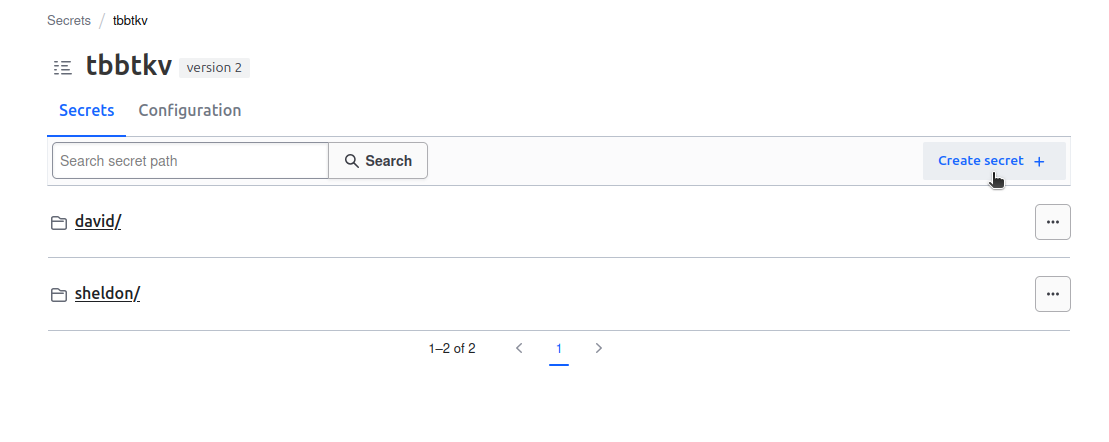
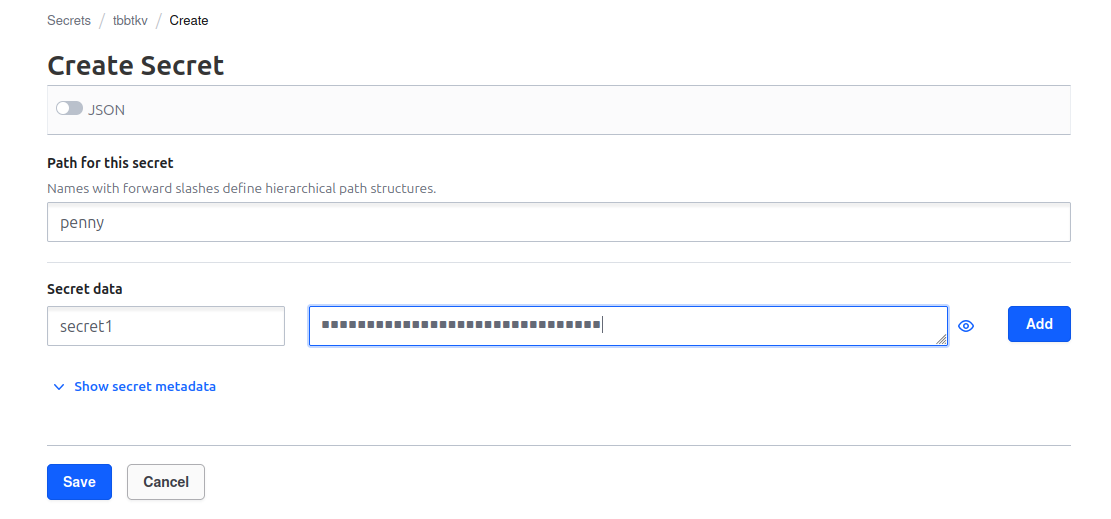
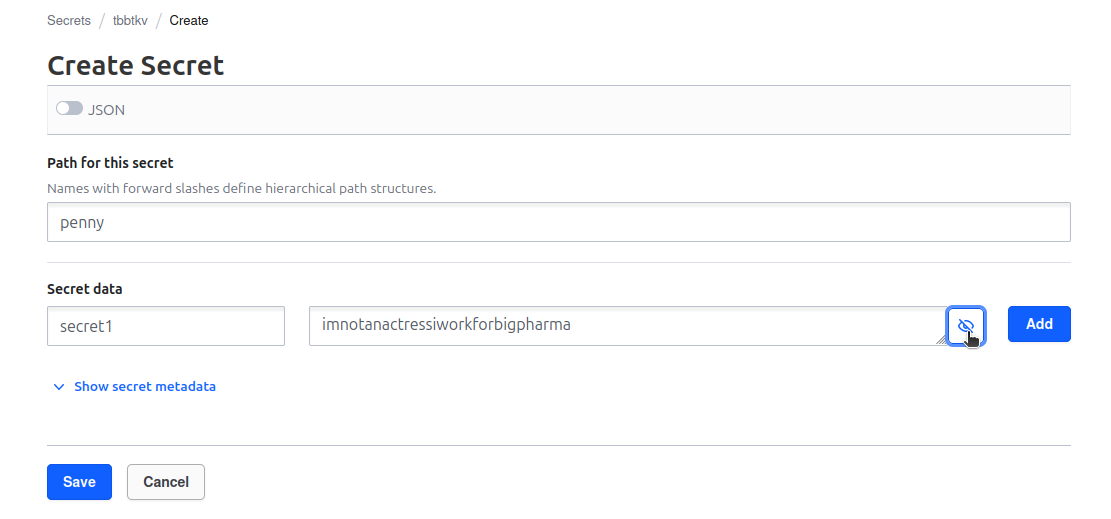
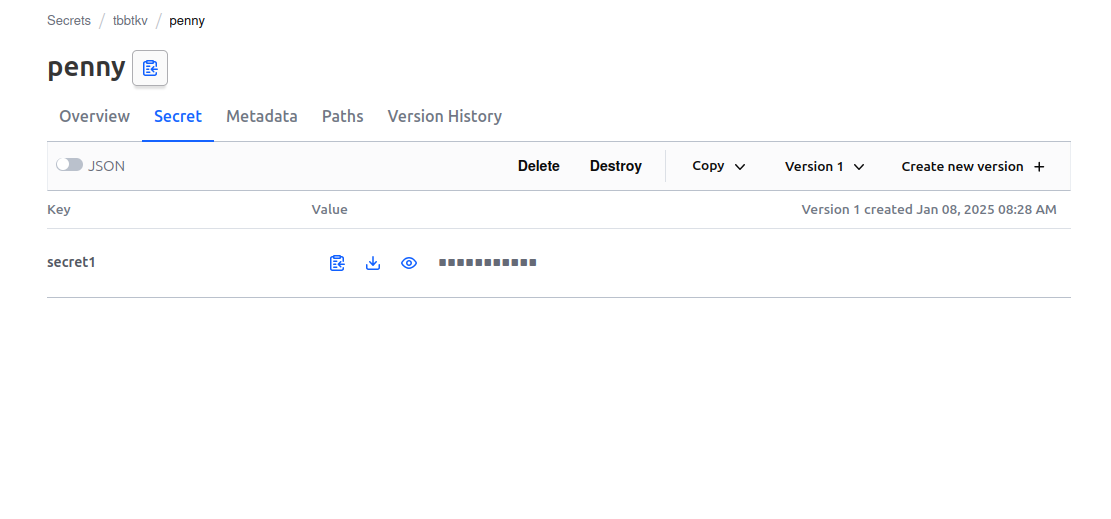
We can also read those secrets with the API
df@df-2404lts:~$ curl --header $vaultheader http://192.168.56.11:8200/v1/tbbtkv/data/david/secret1 | jq .
% Total % Received % Xferd Average Speed Time Time Time Current
Dload Upload Total Spent Left Speed
100 343 100 343 0 0 138k 0 --:--:-- --:--:-- --:--:-- 167k
{
"request_id": "75cd44b6-7ee7-9371-14a5-10229efc7c36",
"lease_id": "",
"renewable": false,
"lease_duration": 0,
"data": {
"data": {
"target": "thisisasecret"
},
"metadata": {
"created_time": "2025-01-03T23:37:19.65449147Z",
"custom_metadata": null,
"deletion_time": "",
"destroyed": false,
"version": 1
}
},
"wrap_info": null,
"warnings": null,
"auth": null,
"mount_type": "kv"
}
df@df-2404lts:~$ curl --header $vaultheader http://192.168.56.11:8200/v1/tbbtkv/data/sheldon/secret1 | jq .
% Total % Received % Xferd Average Speed Time Time Time Current
Dload Upload Total Spent Left Speed
100 352 100 352 0 0 112k 0 --:--:-- --:--:-- --:--:-- 171k
{
"request_id": "3dc4e6ee-0d67-aab1-0e35-55540799579c",
"lease_id": "",
"renewable": false,
"lease_duration": 0,
"data": {
"data": {
"secret1": "iworkondarkmatternow"
},
"metadata": {
"created_time": "2025-01-03T23:52:59.692039011Z",
"custom_metadata": null,
"deletion_time": "",
"destroyed": false,
"version": 1
}
},
"wrap_info": null,
"warnings": null,
"auth": null,
"mount_type": "kv"
}
Or with the cli.
df@df-2404lts:~$ vault kv get -mount="tbbtkv" "penny"
== Secret Path ==
tbbtkv/data/penny
======= Metadata =======
Key Value
--- -----
created_time 2025-01-08T07:28:14.00630809Z
custom_metadata <nil>
deletion_time n/a
destroyed false
version 1
===== Data =====
Key Value
--- -----
secret1 imnotanactressiworkforbigpharma
Let’s try with a secret from Sheldon
df@df-2404lts:~$ vault kv get -mount="tbbtkv" "sheldon"
No value found at tbbtkv/data/sheldon
df@df-2404lts:~$ vault kv get -mount="tbbtkv" "sheldon/"
No value found at tbbtkv/data/sheldon
Wait, what? Let’s dig a little bit.
4. Understanding the path
So we know that we can get the secret from the API.
df@df-2404lts:~$ curl --header $vaultheader http://192.168.56.11:8200/v1/tbbtkv/data/sheldon/secret1 | jq .
% Total % Received % Xferd Average Speed Time Time Time Current
Dload Upload Total Spent Left Speed
100 352 100 352 0 0 112k 0 --:--:-- --:--:-- --:--:-- 171k
{
"request_id": "3dc4e6ee-0d67-aab1-0e35-55540799579c",
"lease_id": "",
"renewable": false,
"lease_duration": 0,
"data": {
"data": {
"secret1": "iworkondarkmatternow"
},
"metadata": {
"created_time": "2025-01-03T23:52:59.692039011Z",
"custom_metadata": null,
"deletion_time": "",
"destroyed": false,
"version": 1
}
},
"wrap_info": null,
"warnings": null,
"auth": null,
"mount_type": "kv"
}
We can note that the path contains the secret name http://192.168.56.11:8200/v1/tbbtkv/data/sheldon/secret1
So from the cli we should add the full path with the secret name.
df@df-2404lts:~$ vault kv get -mount="tbbtkv" "sheldon/secret1"
======= Secret Path =======
tbbtkv/data/sheldon/secret1
======= Metadata =======
Key Value
--- -----
created_time 2025-01-03T23:52:59.692039011Z
custom_metadata <nil>
deletion_time n/a
destroyed false
version 1
===== Data =====
Key Value
--- -----
secret1 iworkondarkmatternow
We can also do this with the full path, instead of specifying the -mount argument.
df@df-2404lts:~$ vault kv get tbbtkv/sheldon/secret1
======= Secret Path =======
tbbtkv/data/sheldon/secret1
======= Metadata =======
Key Value
--- -----
created_time 2025-01-03T23:52:59.692039011Z
custom_metadata <nil>
deletion_time n/a
destroyed false
version 1
===== Data =====
Key Value
--- -----
secret1 iworkondarkmatternow
Let’s create a new secret for Sheldon from the API:
df@df-2404lts:~$ curl --request POST --header $vaultheader --data '{"data": {"secret2": "istillfancystringstheorythough"}}' http://192.168.56.11:8200/v1/tbbtkv/data/sheldon/secret2
{"request_id":"15b255b5-bf40-5c51-8ad9-3433033d2e31","lease_id":"","renewable":false,"lease_duration":0,"data":{"created_time":"2025-01-08T10:40:23.166706673Z","custom_metadata":null,"deletion_time":"","destroyed":false,"version":1},"wrap_info":null,"warnings":null,"auth":null,"mount_type":"kv"}
df@df-2404lts:~$ curl --header $vaultheader http://192.168.56.11:8200/v1/tbbtkv/data/sheldon/secret2 | jq .
% Total % Received % Xferd Average Speed Time Time Time Current
Dload Upload Total Spent Left Speed
100 362 100 362 0 0 44968 0 --:--:-- --:--:-- --:--:-- 45250
{
"request_id": "afff8fc6-77fa-fde5-de2b-d7488642133d",
"lease_id": "",
"renewable": false,
"lease_duration": 0,
"data": {
"data": {
"secret2": "istillfancystringstheorythough"
},
"metadata": {
"created_time": "2025-01-08T10:40:23.166706673Z",
"custom_metadata": null,
"deletion_time": "",
"destroyed": false,
"version": 1
}
},
"wrap_info": null,
"warnings": null,
"auth": null,
"mount_type": "kv"
}
And from the cli
df@df-2404lts:~$ vault kv put tbbtkv/sheldon/secret3 secret3=bazinga
======= Secret Path =======
tbbtkv/data/sheldon/secret3
======= Metadata =======
Key Value
--- -----
created_time 2025-01-08T10:45:56.564217129Z
custom_metadata <nil>
deletion_time n/a
destroyed false
version 1
Notice the end of the command where we specified secret3=bazinga as opposite to the previous occurence of secret creation with the cli here we specified target=<secret_value>.
Checking on the portal we can see all 3 secrets under the tbbtkv/sheldon path
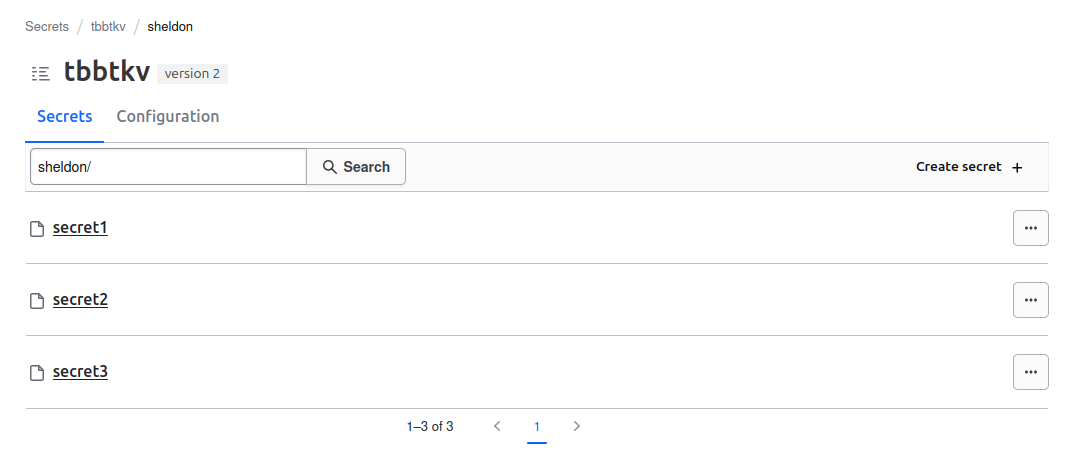
We can see that the key identifying the secret is secret3.

While it is target in our first secret.
df@df-2404lts:~$ vault kv get tbbtkv/david/secret1
====== Secret Path ======
tbbtkv/data/david/secret1
======= Metadata =======
Key Value
--- -----
created_time 2025-01-03T23:37:19.65449147Z
custom_metadata <nil>
deletion_time n/a
destroyed false
version 1
===== Data =====
Key Value
--- -----
target thisisasecret

Adding a secret for Penny that follows the same principles as the secrets created from the cli ou the API, we have to write the path as below.
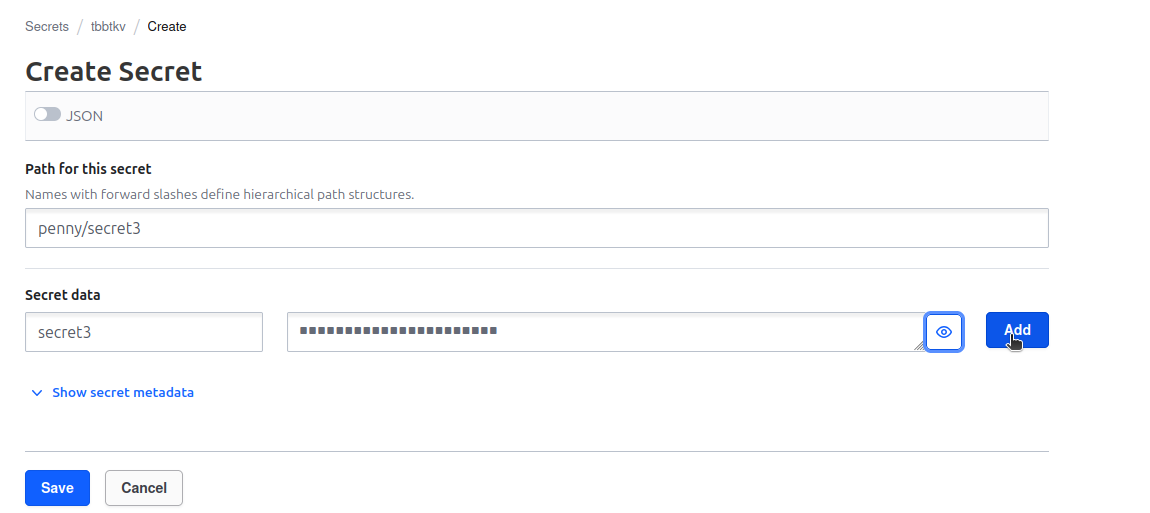
For those who wonders, It is not possible to create a path that ends with a /
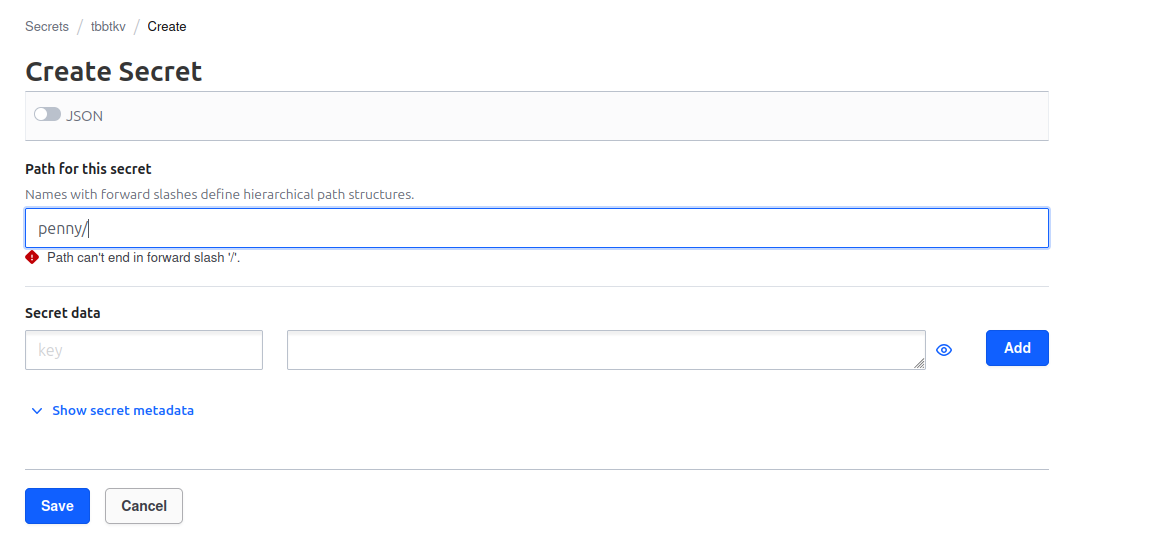
We can clearly see that we have a secret which path is tbbtkv/penny, and others secrets which path are tbbtkv/penny/<secret_name>
Which means that the path should contains the name of the secret. In our case, when we created our penny from the UI, we basically named the secret penny. The key is really not important, It can be anything, as long as the path is clearly identified.
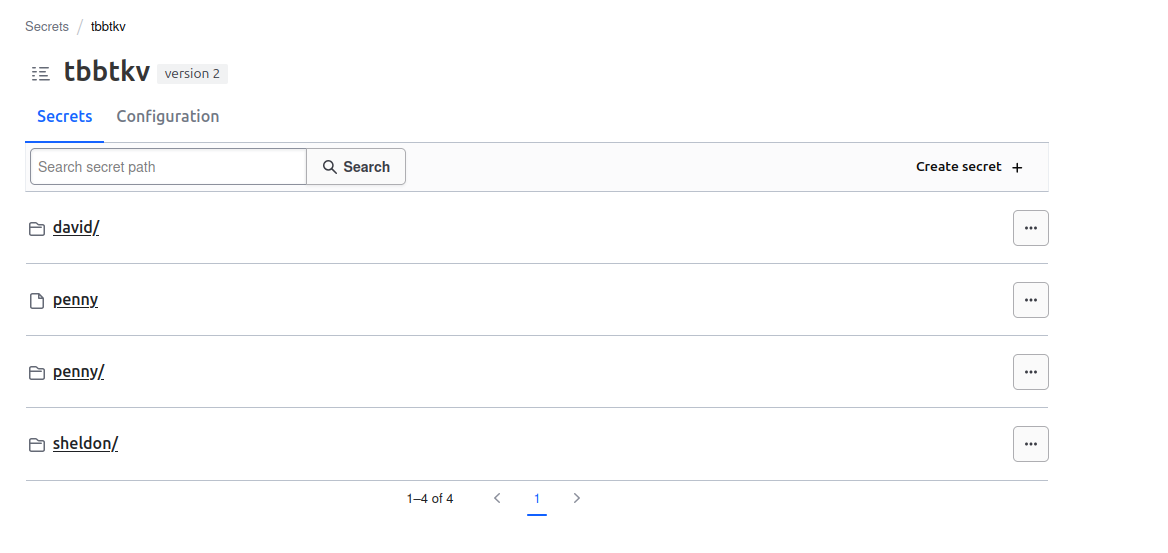

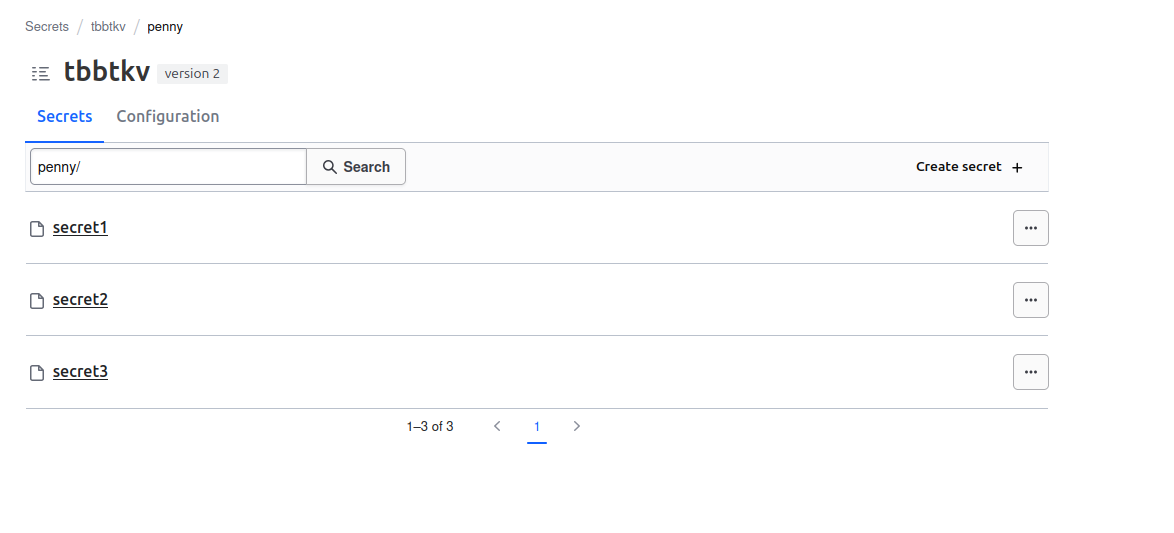
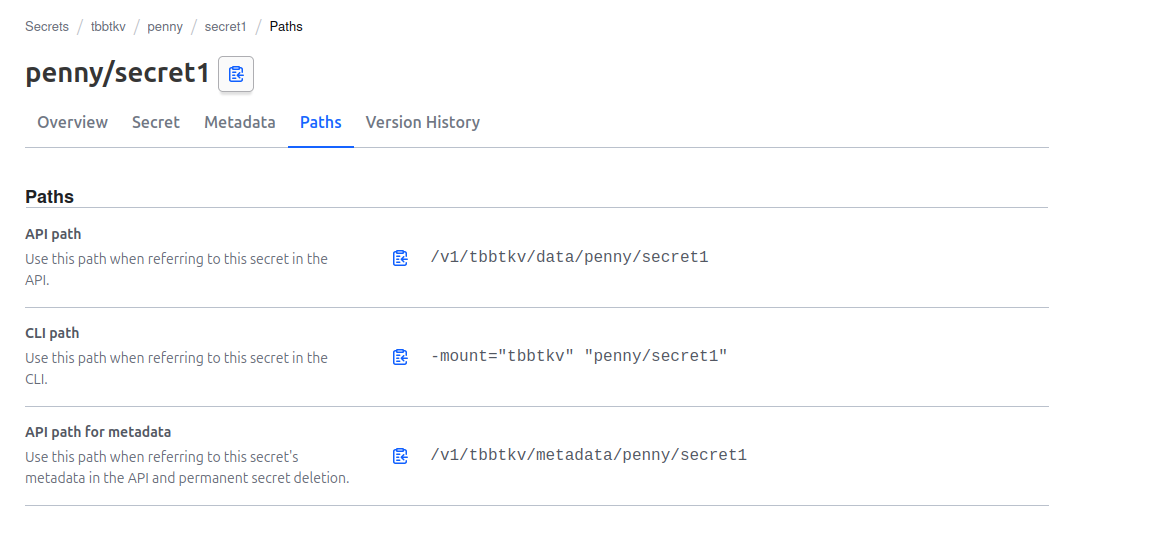
Moving on, let’s have a look at how we can grant access to this Vault server.
5. Managing access to Vault
Now that we have a kv engine available, we want our user to start using it. In the previous section, we did everything as the root user, which is not really the aim right ^^.
So we need to define access, which is done with the policies. Using the vault cli, we can see that there are 2 built-in policies
yumemaru@df-2404lts:~$ vault policy list
default
root
With the vault policy read command, we can have a look at the default policy.
df@df-2404lts:~$ vault policy read default
# Allow tokens to look up their own properties
path "auth/token/lookup-self" {
capabilities = ["read"]
}
# Allow tokens to renew themselves
path "auth/token/renew-self" {
capabilities = ["update"]
}
# Allow tokens to revoke themselves
path "auth/token/revoke-self" {
capabilities = ["update"]
}
# Allow a token to look up its own capabilities on a path
path "sys/capabilities-self" {
capabilities = ["update"]
}
# Allow a token to look up its own entity by id or name
path "identity/entity/id/" {
capabilities = ["read"]
}
path "identity/entity/name/" {
capabilities = ["read"]
}
# Allow a token to look up its resultant ACL from all policies. This is useful
# for UIs. It is an internal path because the format may change at any time
# based on how the internal ACL features and capabilities change.
path "sys/internal/ui/resultant-acl" {
capabilities = ["read"]
}
# Allow a token to renew a lease via lease_id in the request body; old path for
# old clients, new path for newer
path "sys/renew" {
capabilities = ["update"]
}
path "sys/leases/renew" {
capabilities = ["update"]
}
# Allow looking up lease properties. This requires knowing the lease ID ahead
# of time and does not divulge any sensitive information.
path "sys/leases/lookup" {
capabilities = ["update"]
}
# Allow a token to manage its own cubbyhole
path "cubbyhole/*" {
capabilities = ["create", "read", "update", "delete", "list"]
}
# Allow a token to wrap arbitrary values in a response-wrapping token
path "sys/wrapping/wrap" {
capabilities = ["update"]
}
# Allow a token to look up the creation time and TTL of a given
# response-wrapping token
path "sys/wrapping/lookup" {
capabilities = ["update"]
}
# Allow a token to unwrap a response-wrapping token. This is a convenience to
# avoid client token swapping since this is also part of the response wrapping
# policy.
path "sys/wrapping/unwrap" {
capabilities = ["update"]
}
# Allow general purpose tools
path "sys/tools/hash" {
capabilities = ["update"]
}
path "sys/tools/hash/*" {
capabilities = ["update"]
}
# Allow checking the status of a Control Group request if the user has the
# accessor
path "sys/control-group/request" {
capabilities = ["update"]
}
# Allow a token to make requests to the Authorization Endpoint for OIDC providers.
path "identity/oidc/provider/+/authorize" {
capabilities = ["read", "update"]
}
A look at the policy structure tells us that it’s composed of path and capabilities in the hcl format:
path "auth/token/lookup-self" {
capabilities = ["read"]
}
That gives us a bit of information. But how do we create a policy?
Let’s say our scenario is to give on of our user access to his own kv secrets, in the tbbt kv that we created previously.
There’s an interesting argument with vault command to help with the policies creation: the -output-policy. Let’s try it.
I want to be able, as sheldon user, to list all secrets under the path tbbtkv/sheldon. So the vault cli command would be vault kv list tbbtkv/sheldon. Adding the -output-policy, we get this
df@df-2404lts:~$ vault kv list -output-policy tbbtkv/sheldon/
path "tbbtkv/metadata/sheldon" {
capabilities = ["list"]
}
Additionally, Sheldon should be able to create secrets under his own path:
df@df-2404lts:~$ vault kv put -output-policy tbbtkv/sheldon/secret24 secretvalue=bazinga
path "tbbtkv/data/sheldon/secret24" {
capabilities = ["create", "update"]
}
And also read those secrets
df@df-2404lts:~$ vault kv get -output-policy tbbtkv/sheldon/secret24
path "tbbtkv/data/sheldon/secret24" {
capabilities = ["read"]
}
The documentation list the capabilities available for the policies
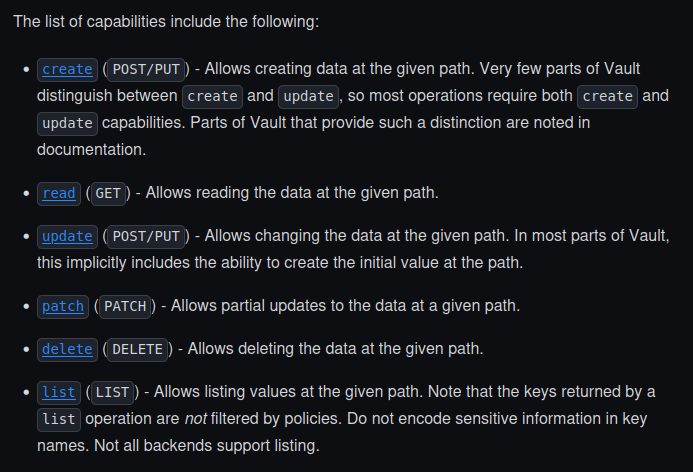
With those additional info, we can write a policy that does what we want:
path "tbbtkv/data/sheldon/*" {
capabilities = ["list", "create", "update", "read", "patch", "delete"]
}
path "tbbtkv/metadata/sheldon/*" {
capabilities = ["list", "create", "update", "read", "patch", "delete"]
}
Notice the use of the glob * which act as a wild card here, for everything under the tbbtkv/data/sheldon/ and the tbbtkv/metadata/sheldon path.
Now let’s create this policy. The command to do this is the following:
df@df-2404lts:~$ batcat sheldon.hcl
───────┬──────────────────────────────────────────────────────────────────────────────────────────────────────────────────────────────────────────
│ File: sheldon.hcl
───────┼──────────────────────────────────────────────────────────────────────────────────────────────────────────────────────────────────────────
1 │ path "tbbtkv/data/sheldon/*" {
2 │ capabilities = ["list", "create", "update", "read", "patch", "delete"]
3 │ }
4 │
5 │ path "tbbtkv/metadata/sheldon/*" {
6 │ capabilities = ["list", "create", "update", "read", "patch", "delete"]
7 │ }
8 │
9 │ path "tbbtkv/*" {
10 │ capabilities = ["list"]
11 │ }
───────┴──────────────────────────────────────────────────────────────────────────────────────────────────────────────────────────────────────────
df@df-2404lts:~$ vault policy write tbbtkv-sheldon ./sheldon.hcl
Success! Uploaded policy: tbbtkv-sheldon
df@df-2404lts:~$ vault policy list
default
tbbtkv-sheldon
root
df@df-2404lts:~$ vault write auth/userpass/users/sheldon policies="tbbtkv-sheldon"
Success! Data written to: auth/userpass/users/sheldon
df@df-2404lts:~$ vault read /auth/userpass/users/sheldon
Key Value
--- -----
policies [tbbtkv-sheldon]
token_bound_cidrs []
token_explicit_max_ttl 0s
token_max_ttl 0s
token_no_default_policy false
token_num_uses 0
token_period 0s
token_policies [tbbtkv-sheldon]
token_ttl 0s
token_type default
Let’s try it out with the Vault UI.
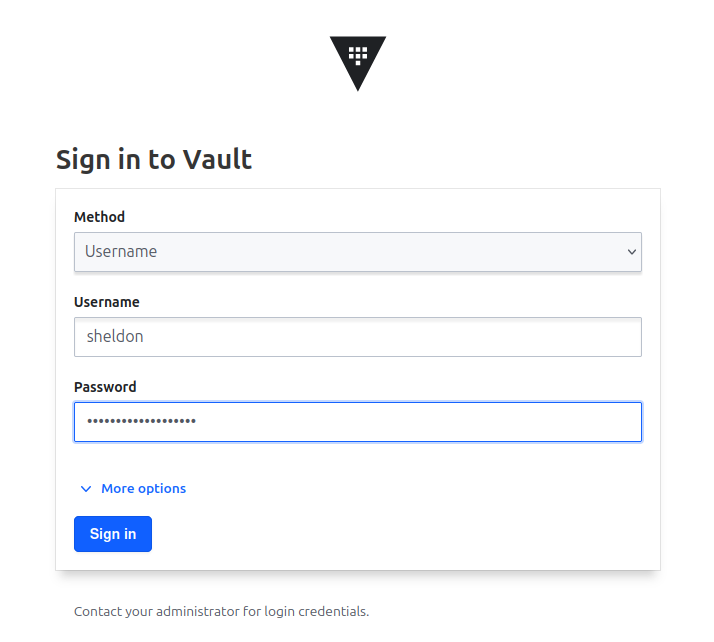
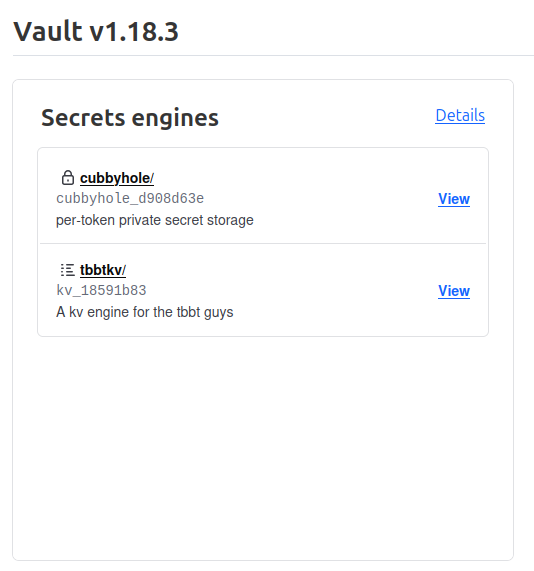
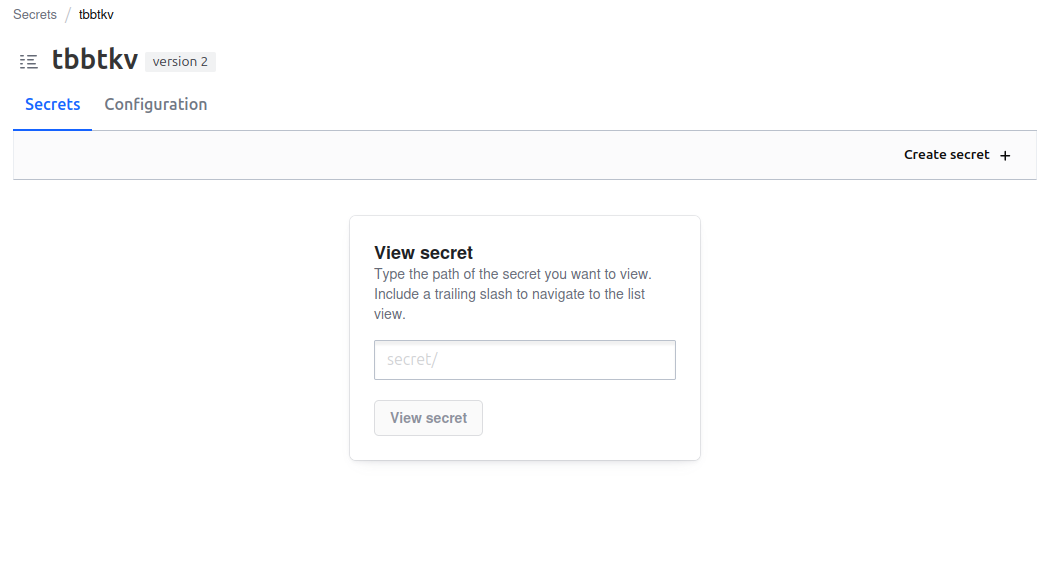
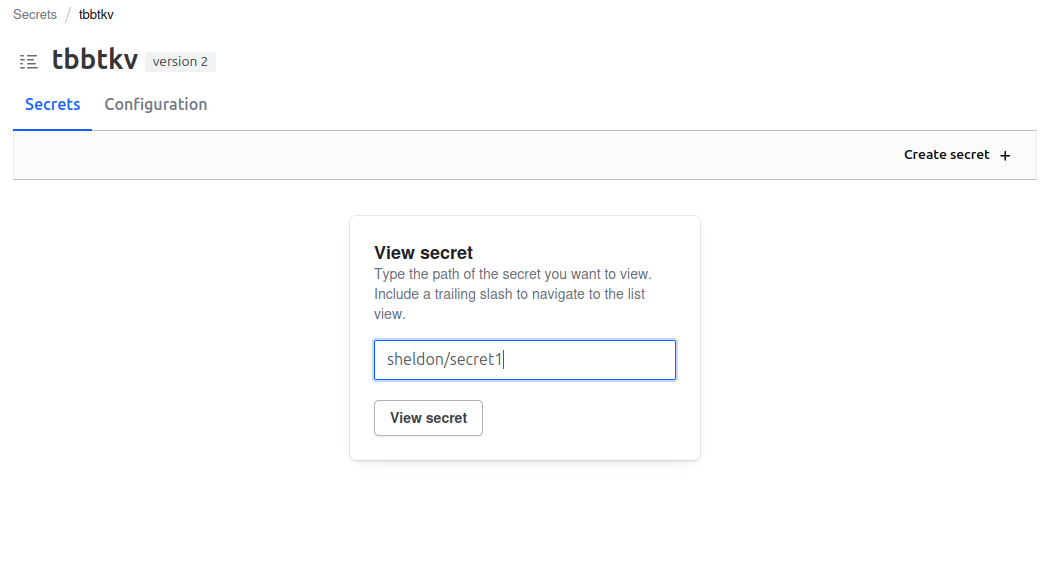
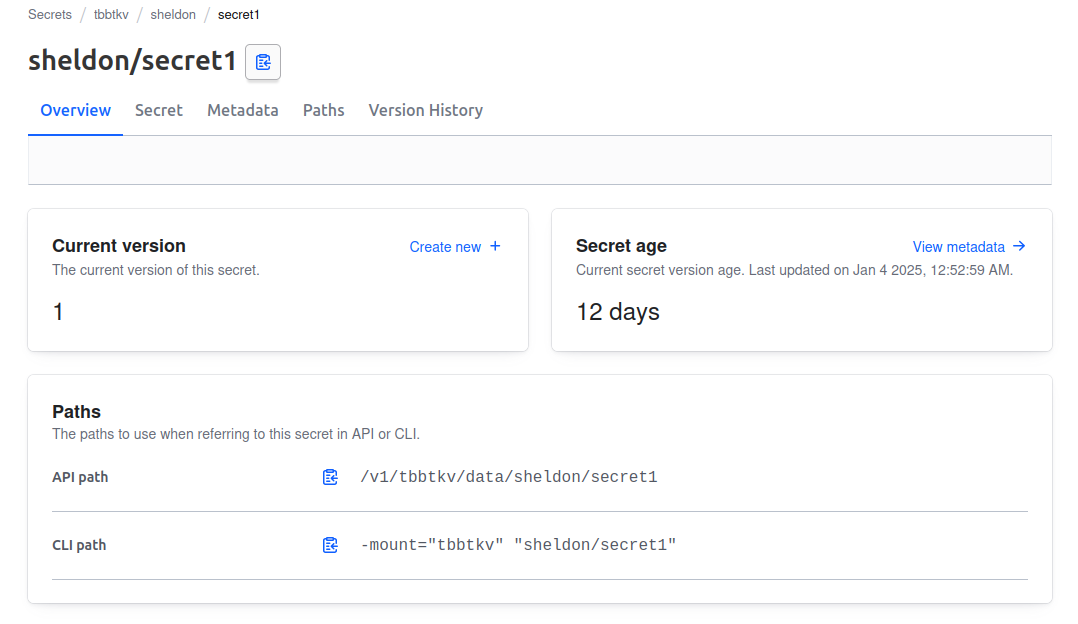

We can, as sheldon, see the secrets in the tbbtkv/data/sheldon/*
However, at this point, we cannot see the existing object just under the kv store tbbtkv. Which makes sense, because it is not present in the policy.
Because it is not very user friendly, we would like to add a list at the root of the tbbtkv path. Using the -output-policy, we get the following:
df@df-2404lts:~$ vault kv list -output-policy tbbtkv/
path "tbbtkv/metadata" {
capabilities = ["list"]
}
Let’s update our policy and try it
df@df-2404lts:~$ batcat ./vaultpolicies/sheldon.hcl
───────┬─────────────────────────────────────────────────────────────────────────────────────────────────────────────────────────────────────────────
│ File: ./vaultpolicies/sheldon.hcl
───────┼─────────────────────────────────────────────────────────────────────────────────────────────────────────────────────────────────────────────
1 │ path "tbbtkv/data/sheldon/*" {
2 │ capabilities = ["list", "create", "update", "read", "patch", "delete"]
3 │ }
4 │
5 │ path "tbbtkv/metadata/sheldon/*" {
6 │ capabilities = ["list", "create", "update", "read", "patch", "delete"]
7 │ }
8 │
9 │ path "tbbtkv/*" {
10 │ capabilities = ["list"]
11 │ }
───────┴─────────────────────────────────────────────────────────────────────────────────────────────────────────────────────────────────────────────
df@df-2404lts:~$ vault policy write tbbtkv-sheldon ./vaultpolicies/sheldon.hcl
Success! Uploaded policy: tbbtkv-sheldon
And Sheldon is not able to see everyting under the tbbtkv path.
Secrets data under tbbtkv/data/sheldon can be accessed, but not the others secrets under other users
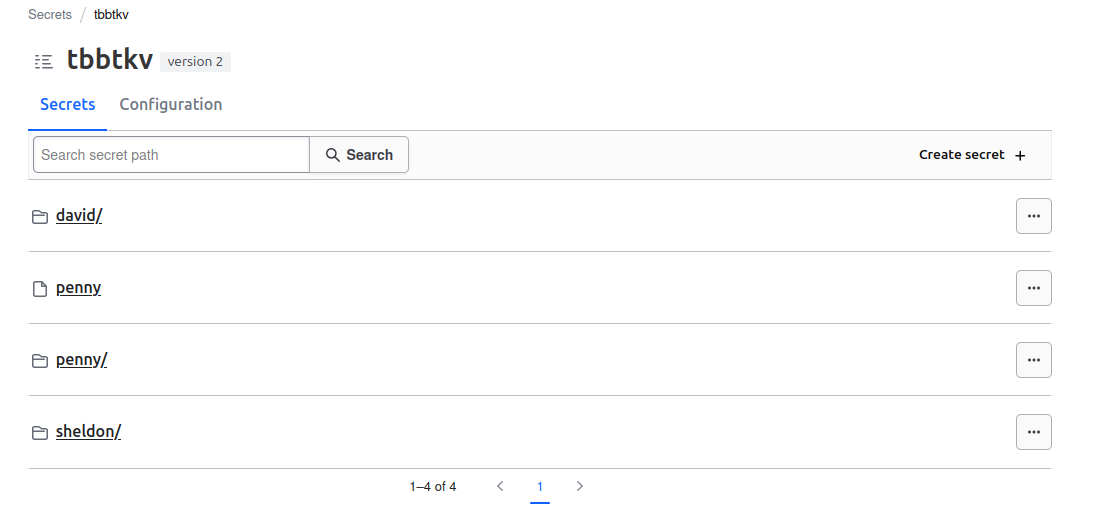
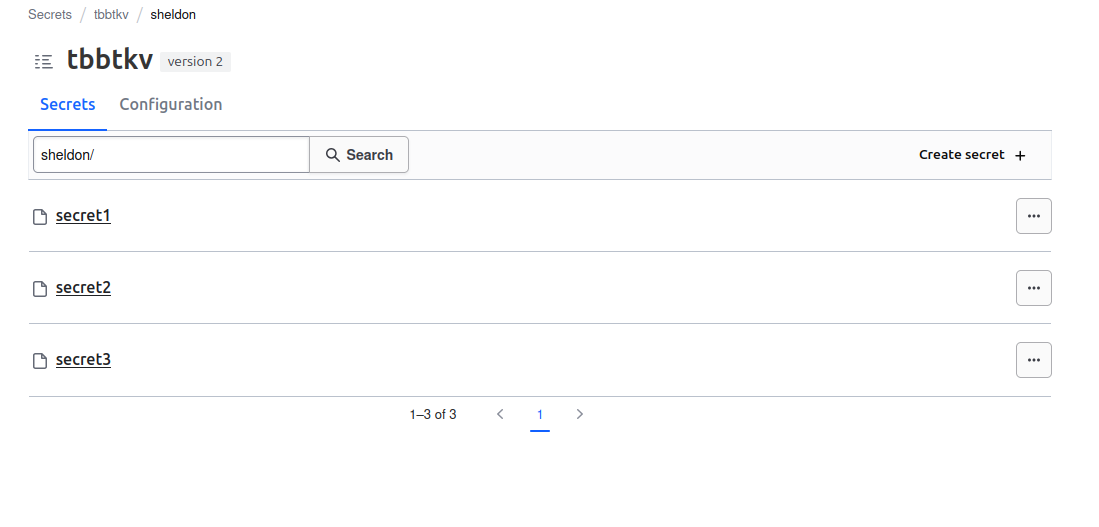
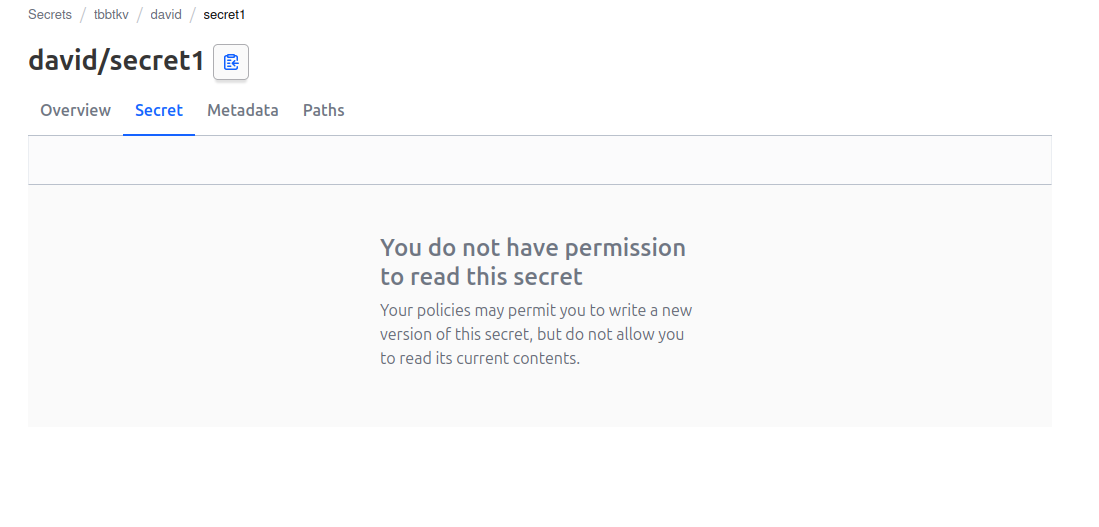
So It seems nice.
Now let’s imagine that each members of the team wants to be able to share some secrets. How could we achieve this?
We have already somehow define that the path for a user is tbbtkv/<user_name>/secret for a secret named secret. Following this logic, each users will store the share-able secrets under the path tbbtkv/<user_name>/shared/*.
Let’s modify the policy for Sheldon first. Using again the -output-policy, we can see the following:
df@df-2404lts:~$ vault kv get -output-policy tbbtkv/sheldon/shared/secretshared1
path "tbbtkv/data/sheldon/shared/secretshared1" {
capabilities = ["read"]
}
We will use the + characters again as below:
df@df-2404lts:~$ batcat sheldon.hcl
───────┬─────────────────────────────────────────────────────────────────────────────────────────────────────────────────────────────────────────────
│ File: sheldon.hcl
───────┼─────────────────────────────────────────────────────────────────────────────────────────────────────────────────────────────────────────────
1 │ path "tbbtkv/data/sheldon/*" {
2 │ capabilities = ["list", "create", "update", "read", "patch", "delete"]
3 │ }
4 │
5 │ path "tbbtkv/metadata/sheldon/*" {
6 │ capabilities = ["list", "create", "update", "read", "patch", "delete"]
7 │ }
8 │
9 │ path "tbbtkv/*" {
10 │ capabilities = ["list"]
11 │ }
12 │
13 │ path "tbbtkv/data/+/sharedsecrets/*" {
14 │ capabilities = ["read"]
15 │ }
───────┴─────────────────────────────────────────────────────────────────────────────────────────────────────────────────────────────────────────────
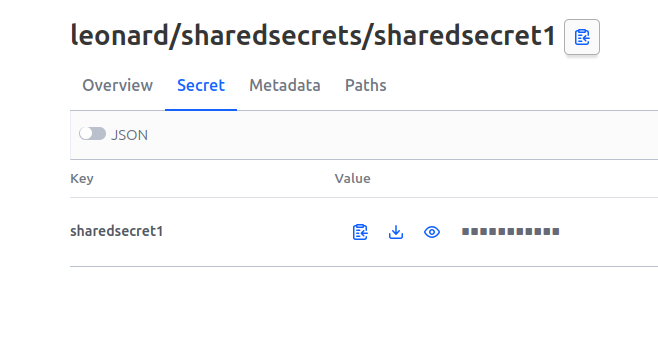
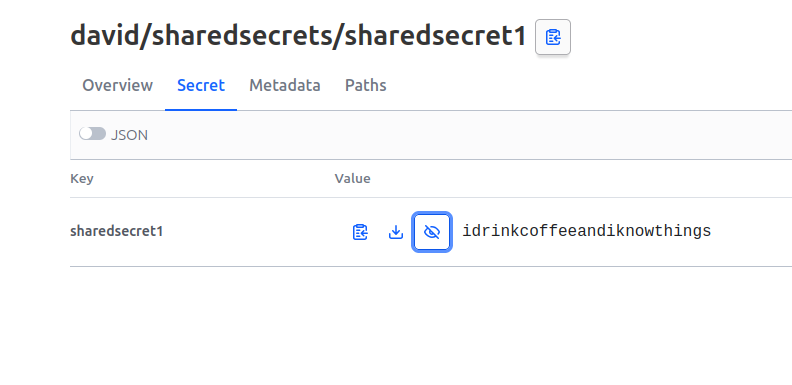
For the purpose of being complete, let’s add policies for Penny and me ^^
df@df-2404lts:~$ batcat penny.hcl
───────┬─────────────────────────────────────────────────────────────────────────────────────────────────────────────────────────────────────────────
│ File: penny.hcl
───────┼─────────────────────────────────────────────────────────────────────────────────────────────────────────────────────────────────────────────
1 │ path "tbbtkv/metadata/penny/*" {
2 │ capabilities = ["list", "create", "update", "read", "patch", "delete"]
3 │ }
4 │
5 │ path "tbbtkv/data/penny/*" {
6 │ capabilities = ["list", "create", "update", "read", "patch", "delete"]
7 │ }
8 │
9 │ path "tbbtkv/*" {
10 │ capabilities = ["list"]
11 │ }
12 │
13 │ path "tbbtkv/data/+/sharedsecrets/*" {
14 │ capabilities = ["read"]
15 │ }
16 │
───────┴─────────────────────────────────────────────────────────────────────────────────────────────────────────────────────────────────────────────
df@df-2404lts:~$ batcat david.hcl
───────┬─────────────────────────────────────────────────────────────────────────────────────────────────────────────────────────────────────────────
│ File: david.hcl
───────┼─────────────────────────────────────────────────────────────────────────────────────────────────────────────────────────────────────────────
1 │ path "tbbtkv/data/david/*" {
2 │ capabilities = ["list", "create", "update", "read", "patch", "delete"]
3 │ }
4 │
5 │ path "tbbtkv/metadata/david/*" {
6 │ capabilities = ["list", "create", "update", "read", "patch", "delete"]
7 │ }
8 │
9 │ path "tbbtkv/*" {
10 │ capabilities = ["list"]
11 │ }
12 │
13 │ path "tbbtkv/data/+/sharedsecrets/*" {
14 │ capabilities = ["read"]
15 │ }
───────┴─────────────────────────────────────────────────────────────────────────────────────────────────────────────────────────────────────────────
df@df-2404lts:~$ vault policy write tbbtkv-penny ./penny.hcl
Success! Uploaded policy: tbbtkv-penny
df@df-2404lts:~$ vault write auth/userpass/users/david policies="tbbtkv-david"
Success! Data written to: auth/userpass/users/david
df@df-2404lts:~$ vault policy list
default
tbbtkv-david
tbbtkv-penny
tbbtkv-sheldon
root
df@df-2404lts:~$ vault read auth/userpass/users/david
Key Value
--- -----
policies [tbbtkv-david]
token_bound_cidrs []
token_explicit_max_ttl 0s
token_max_ttl 0s
token_no_default_policy false
token_num_uses 0
token_period 0s
token_policies [tbbtkv-david]
token_ttl 0s
token_type default
df@df-2404lts:~$ vault read auth/userpass/users/penny
Key Value
--- -----
token_bound_cidrs []
token_explicit_max_ttl 0s
token_max_ttl 0s
token_no_default_policy false
token_num_uses 0
token_period 0s
token_policies []
token_ttl 0s
token_type default
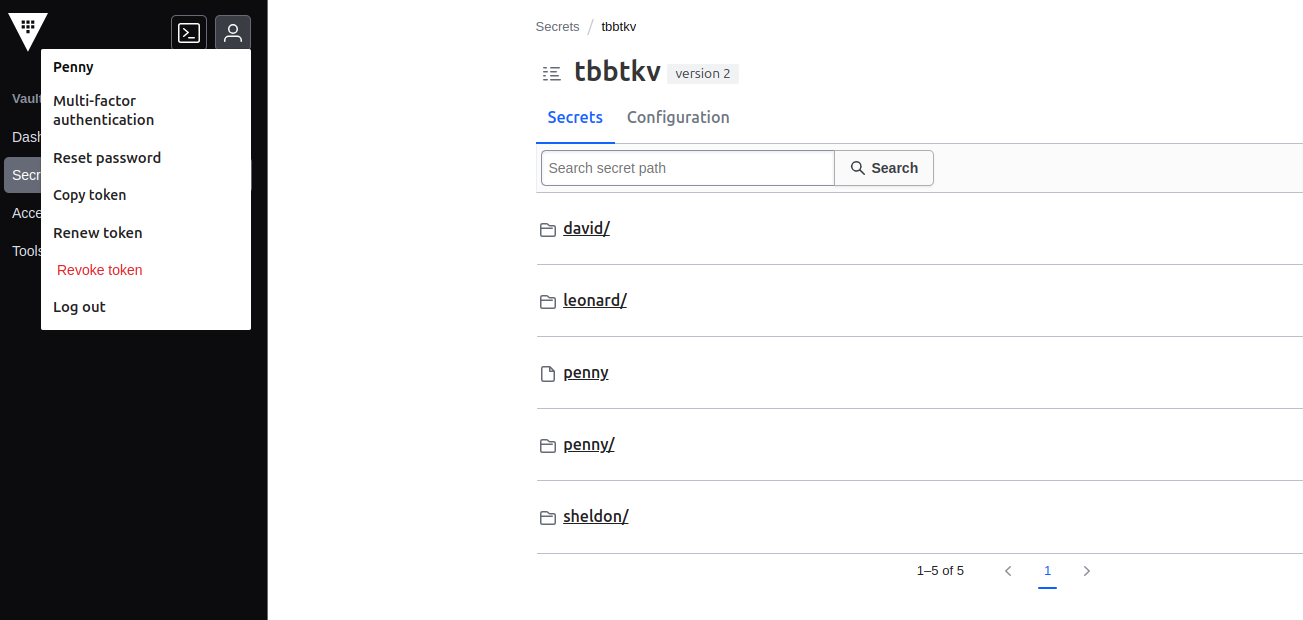

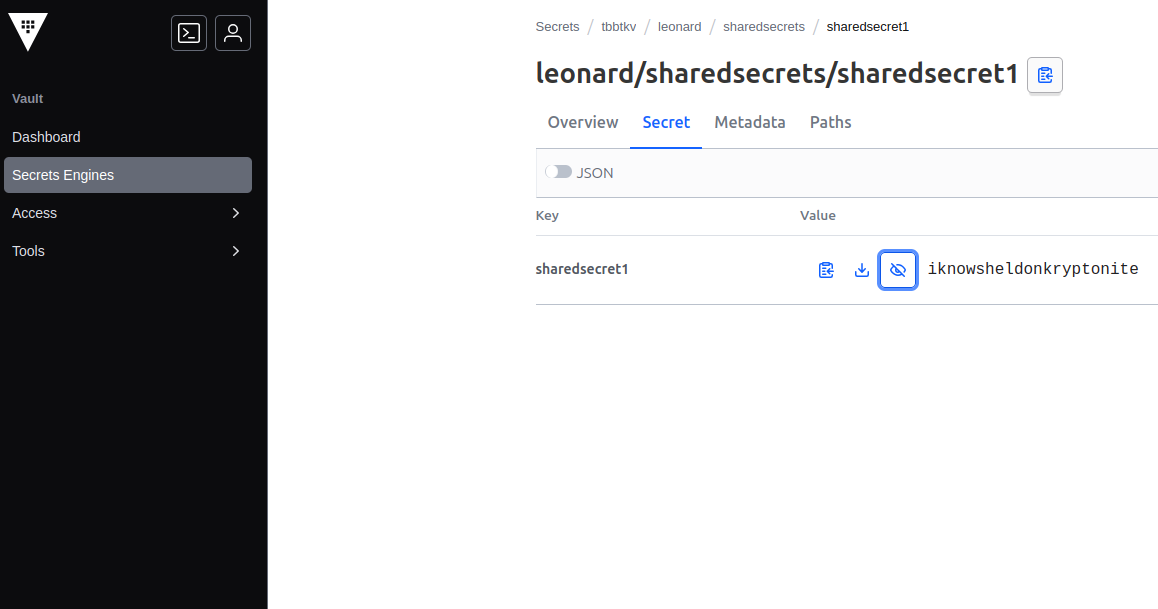
So that’s it.
Let’s conclude because that’smore than enough for now.
4. Summary
In this article, we started from our previous Vault implementation and did the following:
- enabled a kv v2 store
- enabled the userpass authentication
- create policies to grant users access
All in all, at this point, we have something similar to a key vault, with access to a Web UI, or a cli, or an API. In following articles, we will have a look at some automation and more secret engine integration.
See you soon ^^